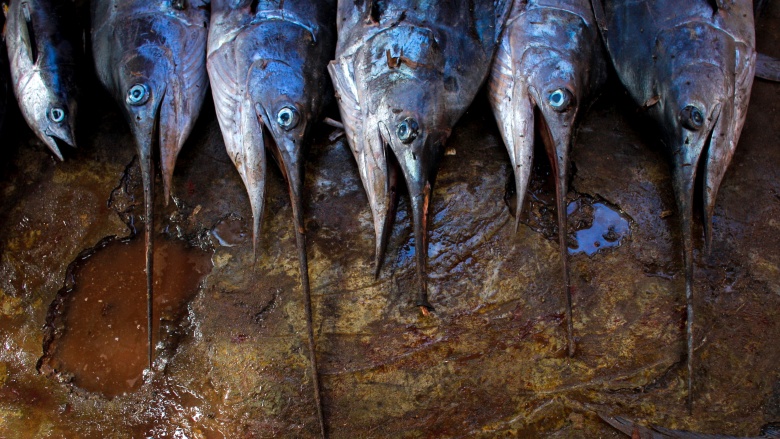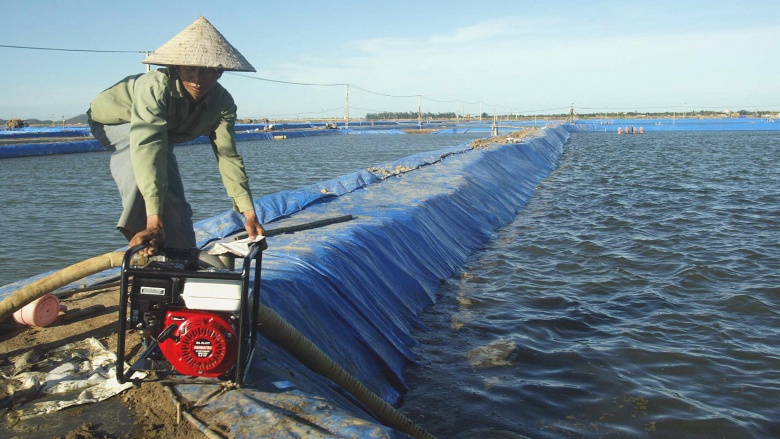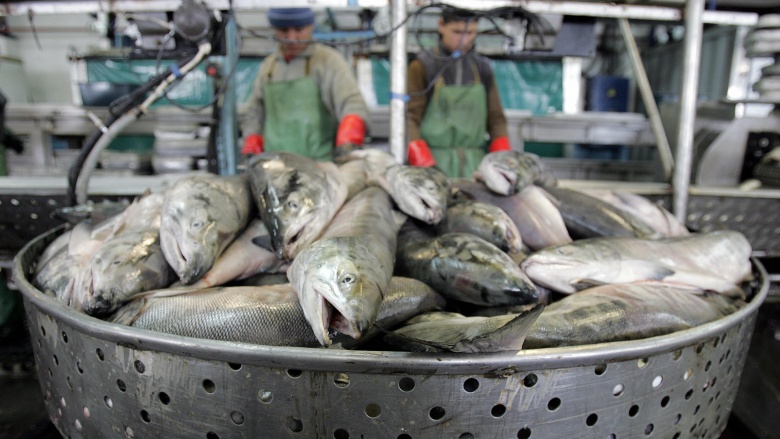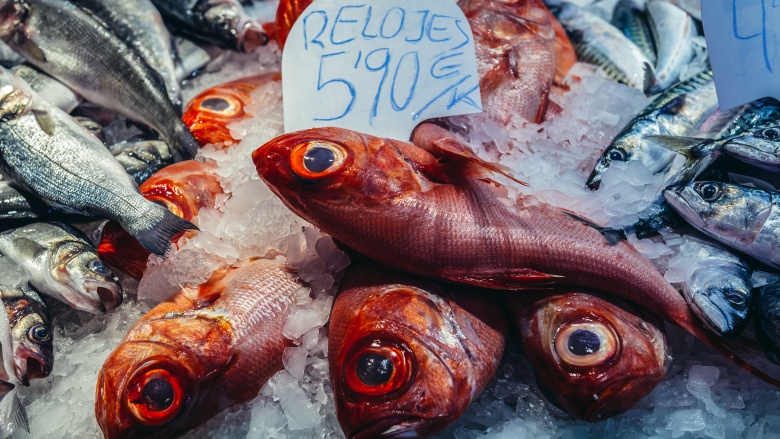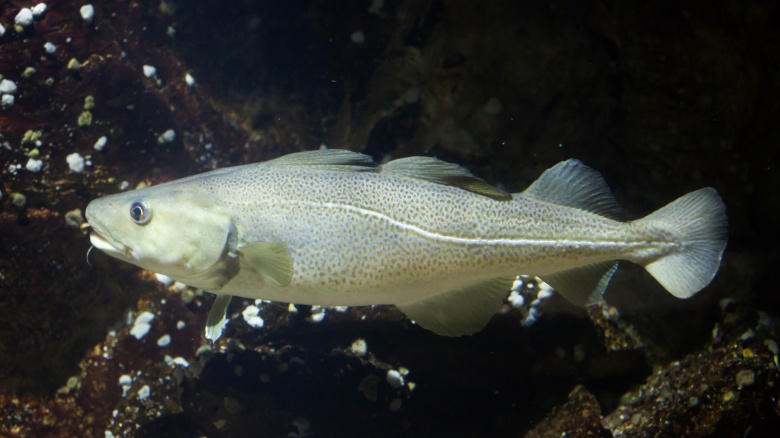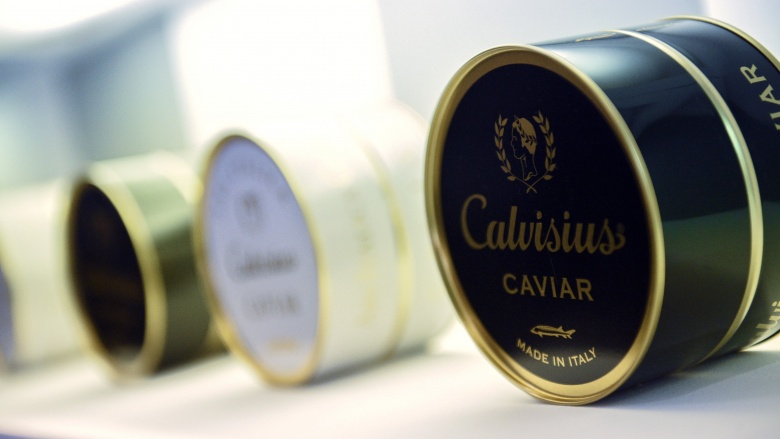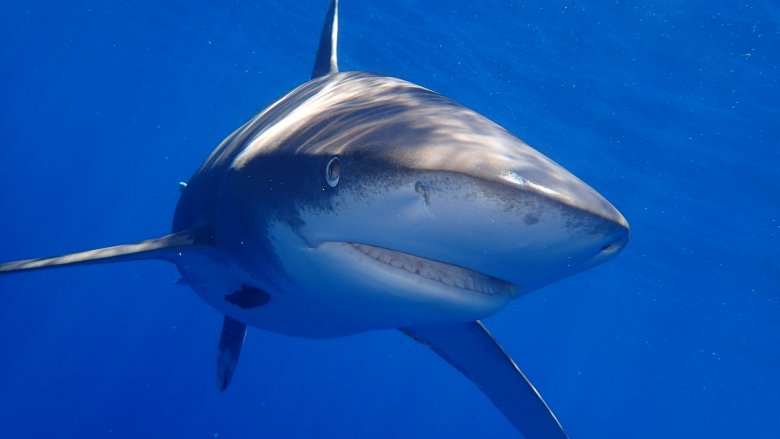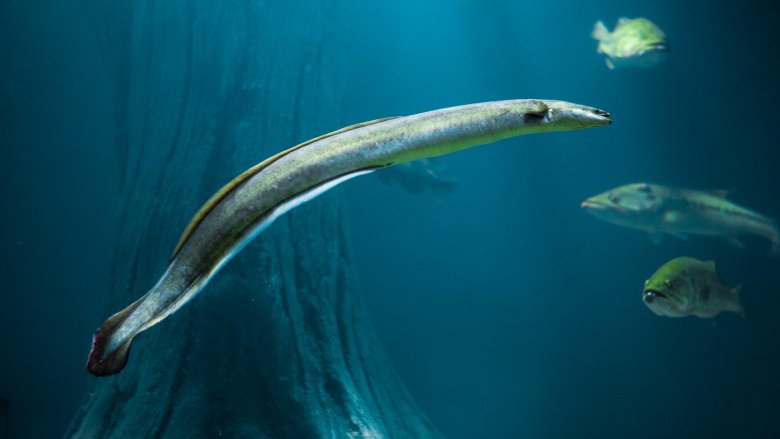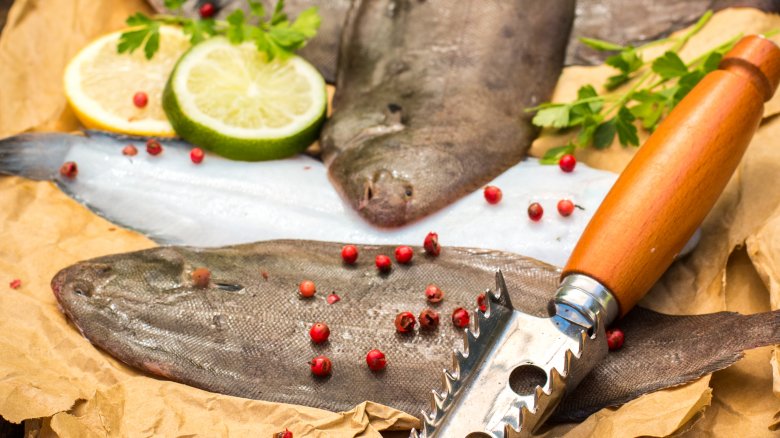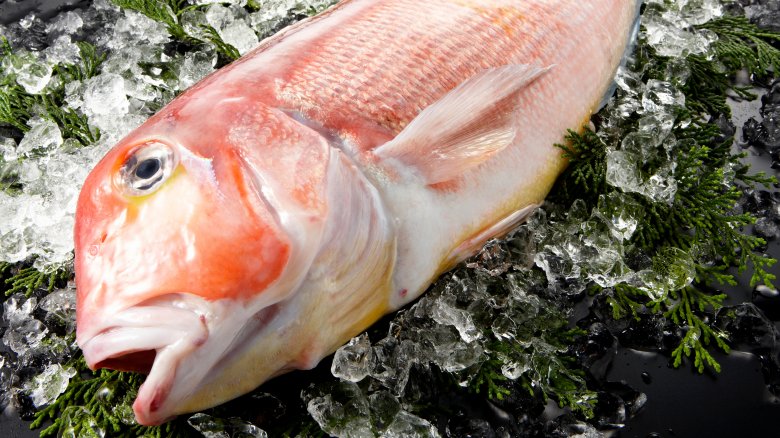The Real Reason You Should Stop Eating These Kinds Of Fish
We are often bombarded with recommendations to eat tons of fish for our health, yet at the same time faced with constant warnings about the sustainability of overfishing, as well as concerns over the high mercury levels in some of our favorite varieties. Mercury, a dangerous neurotoxin that has been linked to heart disease, is no laughing matter — the FDA advises that pregnant women, breastfeeding women, and young children avoid high quantities the stuff as much as possible, due to studies that show it can damage the brains of fetuses when too much exposure occurs. Overfishing is likewise a legitimate concern, as our depleted and polluted oceans risk the extinction of many of the fish we love to eat. So with all that important information in mind, which types of fish should you really strive to avoid? Let's explore the real reasons you should stop eating certain kinds of fish.
Swordfish
Swordfish is a predatory fish. Good news if you are a swordfish, but bad news for us (and any smaller fish that swims in their path). The problem with eating predatory fish? Mercury moves up the food chain, meaning fish like swordfish, shark, mackeral, and marlin are filled to the gills with the stuff. Swordfish have also been victim to overfishing through the years, with restrictions successfully leading to improved numbers in some markets. The most popular method of catching swordfish, however, is long line fishing — a method that threatens endangered species like turtles and sea birds. If you really need to get your swordfish on, shop for fish caught using sustainable methods, and avoid any swordfish from the Mediterranean, where stocks are still very low.
Pacific bluefin tuna
Though a predatory fish itself, the Pacific bluefin tuna is dangerously close to extinction, due to its high-end status among fisherman and sushi lovers the world over. The largest of tuna, an adult Pacific bluefin can reach 1,400 pounds or more. The insatiable demand for the fish has seen record prices — one sold in Japan's Tsukiji market for 1.8 million dollars. Fisherman's quest for the valuable treasure means that the bluefin are being fished before they can reach adulthood, and therefore before they can reproduce. In addition, the migratory nature of tuna means that it is very difficult to establish and enforce rules that prohibit overfishing. As of 2016, populations of Pacific bluefin tuna had declined 97 percent, and the fish is fast on its way to joining the official list of endangered species.
Chilean sea bass
The Patagonian toothfish didn't enjoy much popularity before the 1990s...until a clever fisherman rebranded it the Chilean sea bass. Another fun tidbit to chew on? It's not a bass at all (it's more of a cod,) and most Chilean sea bass doesn't even come from Chile.
Chilean sea bass saw a rise in demand throughout the 90s, and Bon Appétit even named it the Dish of the Year in 2001. But toothfish, who take 10 years to reach sexual maturity, came dangerously close to extinction. In 2002, chefs and fisheries banded together with the "Take a Pass on Chilean Sea Bass" campaign, pledging to keep the fish off restaurant menus until stocks could be replenished. Did it work? Many groups are claiming it did. So why should you continue to avoid it? Unfortunately, toothfish is very high in mercury content, so should still be skipped it if that is a concern for you.
Imported/farmed shrimp
Have you been wondering if shrimp labeled as wild caught is really worth that hefty price tag? Well, if you'd like to avoid virulent bacteria, an overload of antibiotics, and the possibility of your shrimp being injected with what may or may not be industrial gel fillers — the answer is a resounding yes. According to Consumer Reports, the enormous, overseas industrial farms that supply us with our endless supply of cheap shrimp are havens for disease, causing shrimp farmers to employ a bevy of chemicals and antibiotics (which are not permitted for use in shrimp farming in the US). In testing, farmed, imported shrimp have shown to be positive for particularly nasty bacteria like E. coli, vibrio, and MRSA. If bacteria isn't bad enough, imagine if what you're eating isn't completely shrimp at all, but shrimp that has been injected with gelatin to boost the weight, and therefore the price...a problem that has been rampant in Chinese shrimp for years.
Consumer Reports reassures us, though, there are sustainable and reputable shrimp farms out there, who raise shrimp without the use of drugs or chemicals. "We recommend farmed shrimp labeled Naturland, Aquaculture Stewardship Council, or Whole Foods Market Responsibly Farmed."
Farmed salmon
Salmon is a wildly popular choice of fish in restaurants and homes across the US. But the salmon industry's quest to to fill our appetite for affordable and plentiful salmon means most of the salmon we enjoy is not wild, but farmed. So what's the problem? While wild salmon feeds on the organisms found in its environment, farmed salmon is fed a high-fat, commercially processed feed in order to produce larger fish. The resulting salmon is higher in calories and saturated fat, while lower in minerals. Farmed salmon also provides a less favorable ratio of Omega 3 to Omega 6 fatty acids. The farms salmon come from can also be dirty places, with some farmed salmon reported to be high in contaminants. And if you're wary of GMOs, look out. Genetically modified salmon may soon be finding its way to your dinner plate — the FDA approved it in 2015
There are aquaculture companies that strive to deliver farmed salmon that meets a higher standard than most. Look for fish that has been labeled by the Aquaculture Stewardship Council, and ask questions about where your salmon is coming from.
Orange roughy
The verdict is in, and it's a rough one for orange roughy. Appearing on lists of fishes to avoid everywhere from Prevention to Consumer Reports, it seems orange roughy's elevated levels of mercury make it a not-so-smart choice for fish lovers. Once prized for its low calorie and fat content, orange roughy's high amount of mercury has seen it quickly disappearing from restaurant menus and grocery fish cases. The verdict may be good news for the orange roughy population, however. Orange roughy, also known as slimeheads, are believed to be the longest-living fish, with some making it to 150 years and more. Overfishing was leading to the orange roughy being fished before they had a chance to reach full adulthood and reproduce.
Catfish
A majority of the catfish imported into the US comes from Vietnam, a country with lax regulations concerning the use of antibiotics and pesticides in aquaculture. In 2016, Vietnamese swai (a cousin to the American catfish) tested positive for Genetian Violet and Malachite Green, which are known carcinogens and both banned in the US. Nevertheless, the Senate voted to end the USDA's imported catfish inspection program, with accusations the program was nothing more than a bureaucratic attempt to bolster American catfish sales. Whichever side you choose to believe, it's important to note that the Environmental Defense Fund lists Vietnamese catfish, or pangasius as it's called, as one of the worst fish you can eat, due to the filthiness of Vietnamese fish farms.
Atlantic cod
Prized for being the number one choice for fish and chips (the UK imports the most), cod is also used to extract cod liver oil, an in-demand supplement. Unfortunately for cod, this popularity means that Atlantic cod (you may know it as scrod) has been severely overfished. Added to the official WWF list of endangered species in 2000, great measures have been taken to ease up on the fishing of Atlantic cod, but results have been slow to develop. This doesn't mean you have to give up this healthy and versatile fish. Pacific cod stores are plentiful — or you can look for Atlantic cod that gets the stamp of approval from the Marine Stewardship Council.
Beluga caviar
The eggs of the Beluga sturgeon, known as huso huso, Beluga caviar is a high-end delicacy that is considered the finest of all caviars. Once a tightly maintained industry, the dissolution of the USSR made the fish, that is only found in the waters of the Caspian and Black Seas, fair game for fisheries around the globe. In 2005, the US made it illegal to import Beluga caviar from the Caspian sea, where 90 percent of beluga sturgeon live. Despite the fact that the Beluga sturgeon is still critically endangered and its caviar is rare, you can still buy containers of it online, harvested from other regions. Its cousin, the wild ossetra sturgeon, has also been overharvested to the point of almost extinction, and its caviar is currently unavailable anywhere in the world.
Shark
Shark fin soup is a delicacy in Hong Kong, China, and other places, according to Business Insider, but there are some issues when it comes to eating it. Fisherman acquire the shark fins by slicing the fins off a live shark before tossing the body back into the water where, according to First We Feast, the shark either falls to the ocean floor and dies from suffocation or is vulnerable bait for other underwater creatures. Because of this, finning is a very controversial practice.
Beyond that, some experts argue that eating shark isn't sustainable because they breed more infrequently, meaning overfishing is an issue. Additionally, because they grow to be large, sharks have previously been found to contain high levels of mercury.
Finally, in an interview with Rodale's Organic Life, Marianne Cufone, the executive director of the Recirculating Farms Coalition, noted that when sharks are overfished, the species they eat become overgrown, which, in turn, affects some of the other species in the ocean. Though eating shark isn't illegal in the United States — and, in fact, might be more common than consumers realize — it's not your best choice when shopping for a meaty fish for dinner.
American eel
There are a couple of reasons you should give eel a miss when you see it as an option on a menu or at the grocery store, and we'll start with advice from the New York State Department of Health. According to them, in order to minimize your exposure to chemical pollutants like dioxin, mirex, and PCBs, skip the American eel because it tends to have high levels of these chemical compounds.
Then, there's the fact that it wasn't long ago that the American eel joined two other eel species on the Red List of the International Union for Conservation of Nature. In 2014, Scientific American reported that the American eel was "at very high risk of extinction in the wild." (The Japanese eel was also listed as endangered, and the European eel was critically endangered.) The population of the American eel had dropped by about half in just a few short decades, and that's troubling.
Things weren't looking up two years later, either. In 2016, Yale reported that the eel was still endangered, and it was causing some serious problems. Eels are a vital part of river ecosystems (mussels deposit larvae on them, which they then spread — the mussels, in turn, help keep water quality high), and that means other wildlife is suffering.
As of 2019, it's still on the Red List.
Escolar
Mother Jones says it's called the Ex-Lax Fish, and that should probably give you a good idea as to why this one should be avoided like the plague... which is what you'll feel like you have if you partake in escolar a little too much.
Here's the thing: the fish itself has a velvety, creamy texture that's absolutely delicious, but that also means it's easy to eat a whole meal of it. And that's where problems start. That creamy texture comes from wax ester that the human digestive system can't process... so it comes out the other end in an way some sufferers describe as "anal seepage," and others describe (via The Kitchn) as "explosive, oily, orange diarrhea".
It's entirely possible to see it popping up on menus under other names, like white tuna, Hawaiian walu, and butterfish. Some governments and agencies have issued warnings about the gastrointestinal havoc the fish causes, while it's banned completely in Italy and Japan. The FDA has no restrictions in place, though, and doesn't even require restaurants to warn customers. Consider yourself warned.
Sole
Sole is a bottom-feeder, and the problem with this one doesn't have anything to do with the fish — it has everything to do with the fishermen.
According to Greenpeace UK, sole is one of the fish caught by using one of the most destructive fishing methods in the world: bottom trawling. It's essentially the use of massive nets weighted with metal rollers that are dragged across the seabed, scooping up not just the fish they're actually fishing for, but everything else in the way. It's estimated that for every pound of marketable sole the nets dredge up, about 16 pounds of other animals die and are discarded back into the water.
The Marine Conservation Institute says that not only does bottom trawling kill a shocking number of other animals and fish as collateral damage, but it destroys coral reefs and entire seafloor ecosystems. As much as 90 percent of a trawlers' catch isn't what they were fishing for at all, and that's unthinkable.
Tilefish
According to both Healthline and the FDA, tilefish — particularly tilefish sourced from the Gulf of Mexico — is on the short list of fish that should be avoided because of the presence of mercury.
Mercury is absorbed into the food chain through polluted water contaminated, and that contamination is then passed along up the food chain through bigger fish that eat the little ones. When it comes to tilefish, the Environmental Defense Fund's Seafood Selector says different varieties — both from the mid- and south-Atlantic and the Gulf of Mexico — typically have elevated mercury content. It's so bad that they recommend women and children stay away from the fish completely, and men limit themselves to no more than one serving per month.
As if that's not a good enough reason to give this one a miss, they also say that tilefish are extremely vulnerable when it comes to overfishing.

